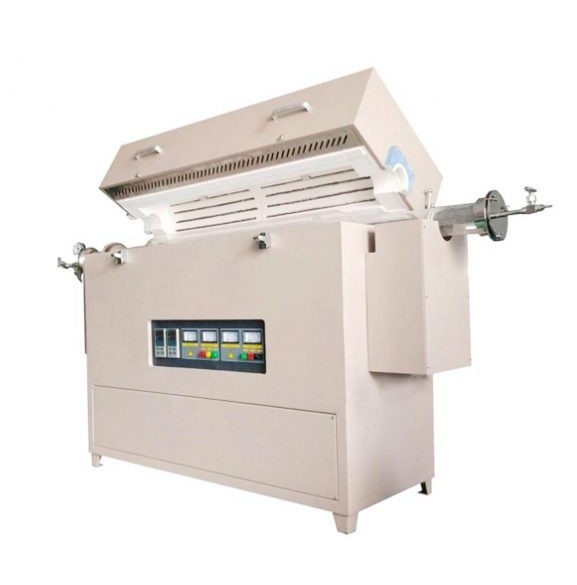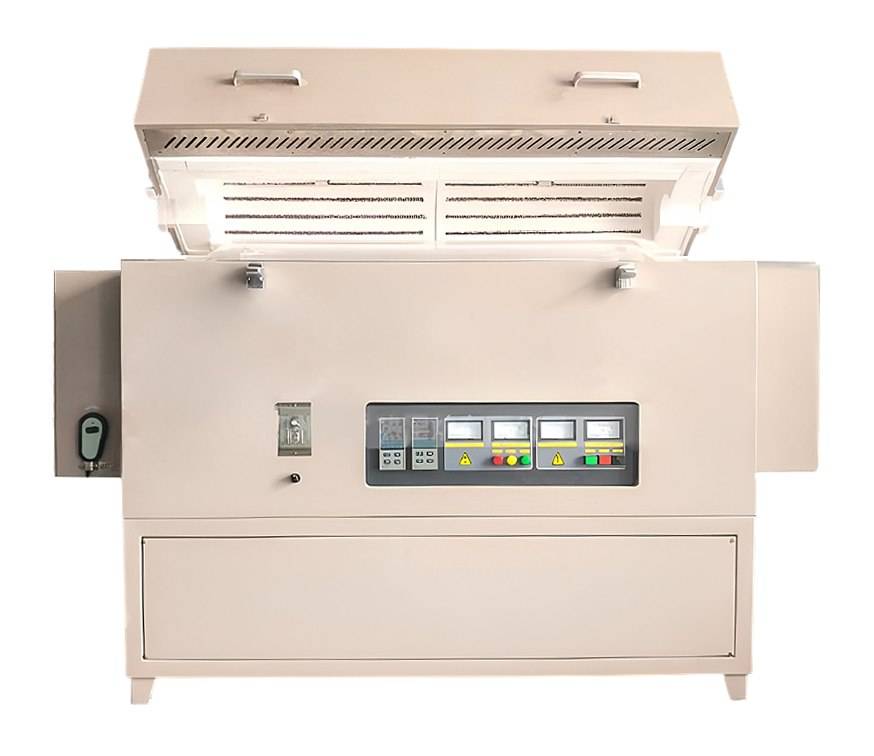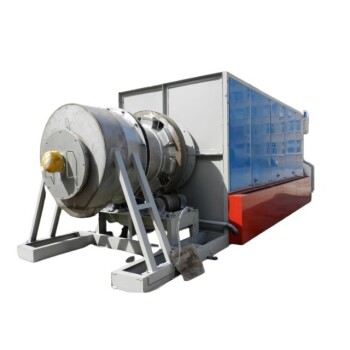
Tube Furnace
Multi Zone Laboratory Quartz Tube Furnace Tubular Furnace
Item Number : KT-MTF
Price varies based on specs and customizations
- Max. temperature
- 1700℃
- Temperature control accuracy
- ±1℃
- Heating zone quantity
- 1-10 zones
Shipping:
Contact us to get shipping details Enjoy On-time Dispatch Guarantee.
Why Choose Us
Reliable PartnerEasy ordering process, quality products, and dedicated support for your business success.

Introduction
A KINTEK Multi-Zone Tube Furnace is a versatile laboratory instrument engineered for demanding high-temperature applications. It features multiple independently controlled heating zones, enabling precise temperature gradients or highly uniform heating across the sample. Typically utilizing high-purity quartz or alumina tubes, these furnaces are essential for advanced material processing and research.
This advanced system offers a wide operational temperature range (up to 1700℃, with constant work at 1650℃), superior temperature control accuracy (±1℃), and efficient heat insulation. It is designed to perform critical processes such as sintering, coating, thermal decomposition, and chemical vapor deposition (CVD) under vacuum or controlled inert gas atmospheres, enhancing the efficiency and reliability of your thermal testing and material synthesis.
Key Features
Our Multi-Zone Tube Furnaces are packed with features designed to elevate your laboratory's capabilities:
- Unparalleled Temperature Precision: Independently control each heating zone to achieve precise temperature distribution (uniformity ±5℃) and create tailored thermal gradients specific to your experimental needs.
- High-Temperature Capability: Reach maximum temperatures of 1700℃ (1650℃ constant working temperature), making it suitable for a wide array of demanding high-temperature applications.
- Customizable Heating Zones: Available with 1 to 10 heating zones, allowing for highly customized temperature profiles to meet unique experimental requirements.
- Efficient & Safe Operation: A double-layer furnace shell design with forced air cooling ensures minimal heat loss, maintains a low surface temperature for operator safety, and improves energy efficiency.
- User-Friendly Control Systems: Choose between a reliable digital PID controller (KT-MTF model) or an advanced touch screen PID controller (KT-MTF Pro model) for intuitive programming, operation, and data monitoring. The Pro model includes multi-program presets and power failure restarting.
- Robust Vacuum and Atmosphere Control: Equipped with high-quality SS 304 stainless steel vacuum flanges and O-ring seals, capable of achieving high vacuum levels (down to 0.001Pa) or maintaining positive pressure (up to 0.02Mpa) for controlled atmosphere experiments.
- High-Purity Sample Environment: Utilizes high-grade Quartz or Al2O3 alumina furnace tubes to ensure minimal sample contamination.
- Advanced Data Management (Pro Model): The KT-MTF Pro's touch screen controller facilitates easy program setting, logs historical data for analysis, and allows for recipe storage, enhancing reproducibility and process insight.
Technical Specifications
| Furnace model | KT-MTF | KT-MTF Pro |
| Temperature controller | Digital PID controller | Touch screen PID controller |
| Multi program preset | no | yes |
| Power failure restarting | no | yes |
| Max. temperature | 1700℃ | |
| Constant work temperature | 1650℃ | |
| Furnace tube material | High grade Quartz/ Al2O3 alumina | |
| Furnace tube diameter | 30 / 40 / 60 / 80 / 100 / 150 / 230 mm (Customizable) | |
| Heating zone length | 300 / 450 / 600 / 800 mm (Customizable) | |
| Heating zone quantity | 1-10 zones | |
| Vacuum sealing solution | SS 304 flange with O ring | |
| Rated vacuum pressure | 0.001Pa / 10E-5 torr | |
| Rated positive pressure | 0.02Mpa / 150 torr | |
| Chamber material | Japan Al2O3 alumina fiber | |
| Heating element | Cr2Al2Mo2 wire coil (or SiC/MoSi2 for higher temperatures, consult for details) | |
| Thermal couple | K / S / B type (selected based on temperature range) | |
| Temperature control accuracy | ±1℃ | |
| Temperature uniformity | ±5℃ (in constant temperature zone) | |
| Electric power supply | AC110-220V, 50/60HZ (Customizable) | |
| Other Al2O3 alumina tube sizes and heating zone lengths can be customized to your specifications. | ||
Applications
KINTEK Multi-Zone Tube Furnaces are indispensable across a wide range of research and industrial applications, including:
- Material Sintering & Annealing
- Advanced Coating Processes (e.g., PVD, ALD pre-treatment)
- Thermal Decomposition Studies
- Chemical Vapor Deposition (CVD) & Growth
- Quenching Tests & Thermal Shock Analysis
- Precise Temperature Measurements & Calibration
- High-Temperature Heat Treatment of Metals, Ceramics, and Composites
- Development of Nano-materials and Semiconductor Materials
- Powder Metallurgy Processes
- Research in New Materials, Petrochemicals, and Aerospace
Advantages of KINTEK Multi-Zone Tube Furnaces
- Enhanced Process Control: Achieve superior control over temperature profiles, crucial for complex thermal processes and achieving desired material properties.
- High Reproducibility: Consistent temperature uniformity and precise control ensure reliable and repeatable experimental outcomes.
- Versatility for Diverse Research: Adaptable for use under vacuum, inert gas, or reactive gas atmospheres, catering to a broad spectrum of material science applications.
- Durable & Reliable Construction: Built with high-quality components, including premium insulation and robust heating elements, for long-lasting performance.
- Optimized for Purity: High-purity furnace tubes and chamber materials minimize contamination, critical for sensitive experiments and material development.
- User-Centric Design: Intuitive interfaces and thoughtful design features simplify operation, reduce setup time, and enhance laboratory productivity.
Safety Advantages
Operate with confidence. KINTEK tube furnaces prioritize your safety with comprehensive built-in protective features:
- Over-Current Protection: The furnace automatically shuts off power if an over-current situation is detected, protecting the equipment and your lab.
- Over-Temperature Alarm & Shutdown: An alarm will sound, and heating will cease if temperatures exceed set limits, preventing overheating.
- Thermocouple Failure Detection: The furnace will stop heating and trigger an alarm if a thermocouple breaks or fails, ensuring process integrity and safety.
- Power Failure Restarting (TFM Pro model): The furnace can automatically resume the heating program from where it left off once power is restored after an outage, saving valuable experiment time and samples.
Operating Principle
The Multi-Zone Tube Furnace operates by precisely heating a sample placed within a tube in a highly controlled environment. The furnace comprises multiple heating zones, each equipped with its own heating elements and thermocouple, controlled independently by the PID system. This allows for the creation of specific temperature gradients along the length of the tube or a highly uniform temperature zone. Samples can be processed under vacuum (achieved via an external vacuum pump connected to the sealed flanges) or in a controlled atmosphere by flowing specific gases through the tube.
Standard Package
| No. | Description | Quantity |
| 1 | Multi-Zone Tube Furnace Main Body | 1 |
| 2 | High-Purity Alumina or Quartz Tube (as per order) | 1 |
| 3 | Vacuum Sealing Flanges with Valves & Gauge Port | 2 sets |
| 4 | Tube Thermal Blocks/Plugs | 2 (or more, depending on zones) |
| 5 | Tube Block Hook/Extractor | 1 |
| 6 | Pair of Heat Resistant Gloves | 1 |
| 7 | Operation Manual & Software (if applicable) | 1 |
Optional Setup & Customization
Tailor your furnace to your exact research needs with our range of optional setups:
- Real-time in-tube gas detection and monitoring (e.g., H2, O2, CO2).
- Independent furnace temperature monitoring and recording systems with data logging.
- RS485/Ethernet communication port for PC remote control, data exporting, and integration.
- Precise gas feeding control systems, including mass flow controllers (MFCs) and float flowmeters.
- Upgraded touch screen temperature controller with advanced programming, data logging, and user management features.
- Comprehensive high vacuum pump station setups, including rotary vane pumps, molecular pumps, and diffusion pumps, complete with all necessary connections and gauges.
- Custom tube diameters, lengths, and materials.
- Specific heating zone configurations and lengths.
Why Choose KINTEK for Your High-Temperature Solutions?
Leveraging exceptional R&D and in-house manufacturing, KINTEK provides diverse laboratories with advanced high-temperature furnace solutions. Our product line, including Muffle, Tube, Rotary Furnaces, Vacuum & Atmosphere Furnaces, and CVD/PECVD/MPCVD Systems, is complemented by our strong deep customization capability to precisely meet unique experimental requirements.
Get Your Customized Multi-Zone Tube Furnace Solution
Ready to enhance your high-temperature processing capabilities? Our experts are here to help you configure the perfect Multi-Zone Tube Furnace for your specific applications. For detailed specifications, to discuss customization options, or to receive a personalized quote, please contact us today. Let KINTEK be your partner in achieving breakthrough results.
FAQ
What Are The Main Applications Of Multi-zone Tube Furnaces?
What Is A Tube Furnace And How Does It Work?
What Are The Common Applications Of A Split Tube Furnace?
What Are The Main Applications Of A Rotary Tube Furnace?
What Is A Vertical Tube Furnace?
What Are The Key Features Of Multi-zone Tube Furnaces?
What Are The Main Applications Of Tube Furnaces?
What Are The Key Features Of A Split Tube Furnace?
What Are The Key Features Of A Rotary Tube Furnace?
What Are The Applications Of A Vertical Tube Furnace?
How Does A Multi-zone Tube Furnace Work?
What Are The Advantages Of Using A Tube Furnace?
How Does A Split Tube Furnace Work?
How Does A Rotary Tube Furnace Work?
What Are The Advantages Of A Vertical Tube Furnace?
What Are The Advantages Of Using A Multi-zone Tube Furnace?
What Types Of Tube Furnaces Are Available?
What Are The Advantages Of Using A Split Tube Furnace?
What Are The Advantages Of Using A Rotary Tube Furnace?
How Does A Vertical Tube Furnace Work?
What Types Of Multi-zone Tube Furnaces Are Available?
What Temperature Ranges Can Tube Furnaces Achieve?
What Temperature Can A Split Tube Furnace Reach?
What Temperature Can A Rotary Tube Furnace Reach?
What Types Of Vertical Tube Furnaces Are Available?
Can Tube Furnaces Operate Under Different Atmospheres?
Why Is The Split Design Beneficial In A Tube Furnace?
What Types Of Materials Can Be Processed In A Rotary Tube Furnace?
Why Choose A Vertical Tube Furnace Over A Horizontal One?
What Makes KINTEK Tube Furnaces Special?
What Temperature Ranges Can Vertical Tube Furnaces Achieve?
Are Vertical Tube Furnaces Customizable?
4.8
out of
5
Incredible precision and durability! The multi-zone control is a game-changer for our lab.
4.7
out of
5
Fast delivery and superb quality. This furnace exceeded all our expectations!
4.9
out of
5
Worth every penny! The advanced technology and robust build make it a lab essential.
4.8
out of
5
Top-notch performance and reliability. Our experiments have never been smoother!
4.7
out of
5
Exceptional value for money. The quartz tube furnace is both efficient and long-lasting.
4.9
out of
5
A technological marvel! The multi-zone feature allows for unparalleled control in our research.
4.8
out of
5
Durable and high-performing. This furnace has significantly boosted our lab's productivity.
4.7
out of
5
Quick setup and outstanding results. Highly recommend for any serious laboratory work!
REQUEST A QUOTE
Our professional team will reply to you within one business day. Please feel free to contact us!
Related Products

High Pressure Laboratory Vacuum Tube Furnace Quartz Tubular Furnace
KINTEK High Pressure Tube Furnace: Precision heating up to 1100°C with 15Mpa pressure control. Ideal for sintering, crystal growth, and lab research. Customizable solutions available.

1200℃ Split Tube Furnace Laboratory Quartz Tube Furnace with Quartz Tube
Discover KINTEK's 1200℃ Split Tube Furnace with quartz tube for precise high-temperature lab applications. Customizable, durable, and efficient. Get yours now!

1400℃ High Temperature Laboratory Tube Furnace with Quartz and Alumina Tube
KINTEK's Tube Furnace with Alumina Tube: Precision high-temperature processing up to 2000°C for labs. Ideal for material synthesis, CVD, and sintering. Customizable options available.

1700℃ High Temperature Laboratory Tube Furnace with Quartz or Alumina Tube
KINTEK's Tube Furnace with Alumina Tube: Precision heating up to 1700°C for material synthesis, CVD, and sintering. Compact, customizable, and vacuum-ready. Explore now!

Vertical Laboratory Quartz Tube Furnace Tubular Furnace
Precision KINTEK Vertical Tube Furnace: 1800℃ heating, PID control, customizable for labs. Ideal for CVD, crystal growth & materials testing.

Split Chamber CVD Tube Furnace with Vacuum Station CVD Machine
Split Chamber CVD Tube Furnace with Vacuum Station - High precision 1200°C lab furnace for advanced materials research. Customizable solutions available.

Laboratory Vacuum Tilt Rotary Tube Furnace Rotating Tube Furnace
KINTEK Laboratory Rotary Furnace: Precision heating for calcination, drying, sintering. Customizable solutions with vacuum & controlled atmosphere. Enhance research now!

Multi Heating Zones CVD Tube Furnace Machine for Chemical Vapor Deposition Equipment
KINTEK's Multi-Zone CVD Tube Furnaces offer precision temperature control for advanced thin film deposition. Ideal for research and production, customizable for your lab needs.

Custom Made Versatile CVD Tube Furnace Chemical Vapor Deposition CVD Equipment Machine
KINTEK's CVD Tube Furnace offers precision temperature control up to 1600°C, ideal for thin film deposition. Customizable for research and industrial needs.

Split Multi Heating Zone Rotary Tube Furnace Rotating Tube Furnace
Precision Split Multi Heating Zone Rotary Tube Furnace for high-temperature material processing, featuring adjustable tilt, 360° rotation, and customizable heating zones. Ideal for labs.

Laboratory Quartz Tube Furnace RTP Heating Tubular Furnace
KINTEK's RTP Rapid Heating Tube Furnace delivers precise temperature control, rapid heating up to 100°C/sec, and versatile atmosphere options for advanced lab applications.

Slide PECVD Tube Furnace with Liquid Gasifier PECVD Machine
KINTEK Slide PECVD Tube Furnace: Precision thin film deposition with RF plasma, rapid thermal cycling, and customizable gas control. Ideal for semiconductors and solar cells.

Inclined Rotary Plasma Enhanced Chemical Deposition PECVD Tube Furnace Machine
KINTEK's PECVD coating machine delivers precision thin films at low temperatures for LEDs, solar cells & MEMS. Customizable, high-performance solutions.

Vacuum Sealed Continuous Working Rotary Tube Furnace Rotating Tube Furnace
Precision rotary tube furnace for continuous vacuum processing. Ideal for calcination, sintering, and heat treatment. Customizable up to 1600℃.

Electric Rotary Kiln Small Rotary Furnace for Activated Carbon Regeneration
Electric Activated Carbon Regeneration Furnace by KINTEK: High-efficiency, automated rotary kiln for sustainable carbon recovery. Minimize waste, maximize savings. Get a quote!

Vacuum Induction Melting Furnace and Arc Melting Furnace
Explore KINTEK's Vacuum Induction Melting Furnace for high-purity metal processing up to 2000℃. Customizable solutions for aerospace, alloys, and more. Contact us today!

High Temperature Muffle Oven Furnace for Laboratory Debinding and Pre Sintering
KT-MD Debinding & Pre-Sintering Furnace for ceramics - precise temperature control, energy-efficient design, customizable sizes. Boost your lab efficiency today!

Mesh Belt Controlled Atmosphere Furnace Inert Nitrogen Atmosphere Furnace
KINTEK Mesh Belt Furnace: High-performance controlled atmosphere furnace for sintering, hardening & heat treatment. Customizable, energy-efficient, precise temperature control. Get a quote now!

Electric Rotary Kiln Small Rotary Furnace Biomass Pyrolysis Plant Rotating Furnace
KINTEK's Rotary Biomass Pyrolysis Furnace converts biomass to biochar, bio-oil, and syngas efficiently. Customizable for research or production. Get your solution now!
Related Articles

Why Your Crystal Growth Experiments Are Failing: The Hidden Culprit in Your Tube Furnace
Struggling with inconsistent CVT results? Discover why your tube furnace's temperature gradient, not your chemistry, is the likely culprit and how to fix it.

Why Your Tube Furnace Is Failing Your Experiments (And It’s Not the Temperature)
Discover the hidden reason your high-temperature experiments fail. It's not your process; it's a material mismatch inside your furnace. Learn how to fix it.

Your Furnace Isn't Just a Heater: Why 'Good Enough' Equipment Is Sabotaging Your Advanced Materials Research
Struggling with inconsistent results from your tube furnace? Discover why standard equipment fails and how a modular, customizable approach is key to success.

Why Your High-Temperature Furnace Fails: The Hidden Culprit Beyond the Cracked Tube
Frustrated by failed high-temp experiments? Learn why replacing parts doesn't work and how a system-engineered furnace ensures reliable, repeatable results.

Why Your High-Temperature Synthesis Results Are Unreliable—And How to Fix It
Struggling with inconsistent results in material synthesis, CVD, or annealing? Discover the hidden cause of failure is your furnace's environment, not your process.

Why Your Thermal Processing Fails: The Hidden Mismatch in Your Furnace
Struggling with inconsistent furnace results? Discover the hidden design mismatch sabotaging your experiments and learn how to choose the right furnace for success.

Cracked Crucibles, Inconsistent Data? The Post-Heating Step You're Missing
Stop blaming your furnace for inconsistent results. Discover how the critical post-heating cooling process sabotages your data and how to solve it for good.

Why Your High-Temperature Experiments Fail—And How to Fix Them for Good
Struggling with inconsistent furnace results? Discover the hidden design trade-offs causing failures and learn how to select a furnace engineered for success.

Why Your High-Temperature Furnace Fails: It’s Not the Heating Element, It’s the Physics
Tired of replacing burnt-out furnace heating elements? Discover the hidden thermal physics that causes premature failure and learn how a systems approach ensures reliability.

Why Your High-Temperature Furnace Delivers Inconsistent Results—And How Geometry Is the Key to Fixing It
Struggling with uneven heating and failed batches in your furnace? Discover the root cause isn't what you think and how to achieve perfect thermal uniformity.

Your Furnace Meets Spec, So Why Are Your Results Inconsistent?
Discover the hidden reason your high-temperature experiments fail: poor thermal uniformity. Learn how to fix it by moving beyond standard furnace specs.

Why Your High-Temperature Experiments Are Failing—And It's Not What You Think
Frustrated with inconsistent results from your furnace? Discover why max temperature isn't the problem and how to achieve perfect thermal uniformity.